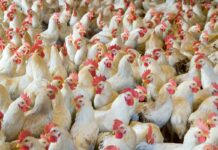
The poultry industry has been using the same anticoccidial drugs for the prevention of coccidiosis for several decades. The last approval of a new anticoccidial compound in the United States by the Food and Drug Administration was in 1999 and currently no animal health company is actively working on developing new ones.
In addition, in the United States, anticoccidials of the polyether ionophore class are considered antimicrobials and therefore cannot be used in the production of poultry raised without antibiotics like the ones bearing the labels “No Antibiotics Ever” (NAE) or “Raised Without Antibiotics” (RWA).
The production of poultry raised without antibiotics has skyrocketed in recent years due to concerns about the potential for transfer of antimicrobial resistance from poultry products to humans, relentless pressure from activist groups, consumer preferences and marketing campaigns. This has put the poultry industry in a difficult position as coccidiosis prevention must be achieved relying exclusively on the use of chemically-synthetized anticoccidials, the so-called “chemicals” and live vaccines. Although with a few exceptions like nicarbazin that has been used successfully every year since 1955, chemically-synthetized anticoccidials are more prone to the development of resistance, and when resistance develops, control of coccidiosis becomes more difficult.
Coccidiosis control is an important factor in the prevention of necrotic enteritis (NE) which has emerged as a significant disease in poultry raised without antibiotics, this may be due to partial resistance to chemical anticoccidials coupled with lack of antibiotic effect from chemical anticoccidials and no use of antimicrobials with good anticlostridial activity and ionophores. On the other hand, the use of live vaccines has also increased significantly in recent years paralleling the increase in the production of poultry raised without antibiotics. Even though live vaccines are effective when properly administered, they have to cycle several times through the intestines in order to produce immunity. As a result, mild intestinal lesions are produced and since no antibiotics with anticlostridial activity can be used in raised without antibiotics production; the use of live vaccines without antibiotics has more than likely played a role as well in the emergence of NE as a significant disease in poultry raised without antibiotics.
Anticoccidial sensitivity tests (ASTs) have been developed and used to predict the efficacy of anticoccidial drugs in the field. These tests can be very useful when properly conducted and interpreted. With the current trends in poultry production, ASTs are one of the most valuable tools available to producers to manage coccidiosis control successfully in the long term.
Introduction – What is an AST?
An AST is a laboratory test in which coccidia isolated from field samples (usually litter or droppings) from different farms from a production complex are tested under controlled conditions for sensitivity to various anticoccidial drugs with the purpose of predicting their efficacy in the field.
Why are ASTs important?
In order to optimize the selection of prophylactic medication in the field, knowledge about the sensitivity profile of the parasites in question is essential. AST is the best method currently available to assess and predict the efficacy of anticoccidial drugs against field isolates of Eimeria spp. in commercial broiler production. The importance of conducting ASTs for early detection of resistance or “reduced sensitivity” before flock productivity is adversely impacted has been emphasized by several researchers and field veterinarians.
ASTs are also used to determine anticoccidial efficacy in drug approval studies. They are a useful predictor of anticoccidial efficacy when local Eimeria spp. isolates are used by a commercial production complex and they are also useful to detect early changes in sensitivity to anticoccidial drugs.
How is the sensitivity determined?
Sensitivity can be determined in various ways, some have suggested by comparing differences in body weight gain between the treated group and the negative and positive controls (8), while others have suggested excretion of oocysts, an anticoccidial index or body weight gain and feed conversion. However, since anticoccidial drugs are designed to prevent coccidiosis, according to L.R. McDougald, comparing percent reductions in lesion scores between treated and negative and positive controls is the most important parameter to detect changes in sensitivity. Therefore, although body weight gain, feed conversion ratio and livability are recorded for their economic importance, in this presentation, percent reduction in lesion scores will be the parameter used to assess sensitivity of field isolates of coccidia.
Sample collection and submission
Before collecting samples, it is important to determine what anticoccidial drugs and what dietary inclusion rates will be used in the ASTs so that the laboratory ensures that they have all the anticoccidial drugs needed within the expiration period. It is also a good idea to mix all the treatment diets ahead of time and conduct drug assays for each treatment that includes anticoccidial drugs before the start of the ASTs to ensure that anticoccidials were mixed properly.
A very important part of an AST is the collection and submission of samples to the laboratory. This is important to preserve the viability of the oocysts present in the sample and to have a truly representative sample of the Eimeria spp. present in the production complex where the samples were collected. Since it is not possible, or necessary, to sample every house in a production complex, a number of samples (between 5 to 10) will suffice. As stated by H.D. Chapman: “it is likely that the results for one farm will be similar to other farms within the same complex, providing the same drug programs have been employed.”
Litter or droppings samples should be collected from at least six locations in a zig-zag pattern from the brooder end of the house. If litter is collected it should be collected from the upper one-third of the litter and enough to fill a gallon container and if droppings are collected there should be at least 24 fresh droppings collected including intestinal and cecal droppings. To increase the probability of recovering enough oocysts to prepare the inocula from the first pass, samples should be collected from flocks that are between 21 and 28 days old.
The samples should be shipped to the laboratory where the ASTs will be conducted in a well-sealed cooler by overnight express delivery mail and a few ice packs should be included to prevent the samples from overheating during transport. Samples should be prevented from overheating but not allowed to freeze as both excessive heat and cold are detrimental to oocyst survivability.
Brief description of the test
Inoculum
Upon reception of litter or dropping samples, these are mixed with feed and fed to coccidia-free broiler chicks kept in cages with wire floors. Droppings from these birds are collected from days four to seven, and the oocysts recovered, cleaned, sporulated, and titrated (~105 sporulated oocysts/mL). Once prepared the inoculum is stored under appropriate conditions until the day of the challenge.
AST
On the first day of the test, chicks are received from the hatchery and placed at random in coccidia-free floor pens with new shavings. They are fed a standard starter feed free of any anticoccidial compounds until day 12. On day 12, the chickens are assigned at random to each cage (usually eight per cage) and switched to their respective treatment diets. There are usually three to five replicates/treatment. The chickens assigned to the negative and positive controls continue receiving unmedicated feed while the treated birds are fed diets containing the anticoccidials at the dietary concentrations to be tested in each treatment. On day 14, all chickens except the negative control are infected with the inoculum previously prepared from the litter or droppings samples and titrated to contain approximately 105 sporulated oocysts of mixed Eimeria spp./mL. The inoculum is administered by oral gavage with a graduated syringe. The inoculum usually contains a mix of Eimeria acervulina, E. maxima, and/or E. tenella. Also on day 14, all chickens are weighed by cage and the average weight per chicken calculated and used as the initial weight for the AST. At this time, the amount of feed administered to each cage is also recorded in order to calculate feed conversion ratio at the end of the test. On day 20, all the chickens in each cage are weighed again in order to calculate average body weight gain. Also on day 20, the remaining feed is weighed in order to calculate the feed conversion ratio for each treatment. At the same time, the chickens are humanely euthanized in order to remove the intestinal tracts and score the severity of the intestinal lesions induced by the coccidial challenge by the method of Johnson and Reid.
Interpretation
Based on the manuscript by L.R. McDougald, if lesion scores for any given region of the intestinal tract (upper, middle, lower or ceca) are reduced by 50% or more, the isolate is considered sensitive to the respective anticoccidial. If lesion scores are reduced between 49 and 30%, the isolate is considered intermediate in sensitivity to the respective anticoccidial. If the lesion scores are reduced 29% or less, the isolate is considered resistant to the respective anticoccidial.
Other considerations
Even though an AST only lasts 20 days, samples must be submitted and passed in chicks to prepare the inoculum and then chicks must be ordered ahead of time, feeds mixed, and results summarized so in reality expecting results earlier than six weeks, and more than likely eight weeks, is not realistic. Ideally, a preliminary dose titration study should be conducted with the isolates in order to find the dose that will produce enough gross lesions and growth depression without mortality (this will add to the time in which results can be expected to be completed).
The most benefit from conducting ASTs is derived from testing samples from a complex at least once per year. Over time, a reasonable assessment of efficacy and resistance can be produced and used to design more effective coccidiosis prevention programs in which chemotherapy is the main means of control.
Likewise, for consistency it is better to use the same facility for ASTs. It is also important to submit representative samples ensuring they are not exposed to direct sunlight, excessive heat or cold and that they are shipped by express mail delivery to favor the survivability of the oocysts. Remember that having to perform a second pass is undesirable as the proportion of Eimeria spp. in the original sample can change and give a false assessment of sensitivity.
Submission forms must be filled out completely noting the previous anticoccidial use history and detailing what anticoccidial drugs and dosages are to be tested.
Conclusion
As the poultry industry grows a larger percentage of birds without ionophore anticoccodials and relies more on chemically-synthetized anticoccidials, ASTs can provide a very valuable tool to design more effective anticoccidial programs for the prevention and control of coccidiosis.
Maintaining efficacy of anticoccidial drugs to prevent coccidiosis is important to minimize the incidence of necrotic enteritis, which has emerged as a major disease in poultry raised without antimicrobials.
References are available on request
From the Proceedings of the 70th Western Poultry Disease Conference – 2021















